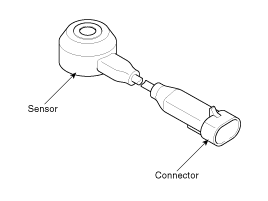Hyundai Tucson: Engine Control System / Knock Sensor (KS) Description and Operation
Hyundai Tucson (LM) 2010-2015 Service Manual / Engine Control / Fuel System / Engine Control System / Knock Sensor (KS) Description and Operation
| Description |
Knocking is a phenomenon characterized by undesirable
vibration and noise and can cause engine damage. Knock Sensor (KS) is
installed on the cylinder block and senses engine knocking.
When knocking occurs, the vibration from the cylinder block
is applied as pressure to the piezoelectric element. When a knock
occurs, the sensor produces voltage signal. The ECM retards the ignition
timing when knocking occurs. If the knocking disappears after retarding
the ignition timing, the ECM will advance the ignition timing. This
sequential control can improve engine power, torque and fuel economy.

 Camshaft Position Sensor (CMPS) Repair procedures
Camshaft Position Sensor (CMPS) Repair procedures
Inspection
1.
Check the signal waveform of the CMPS and CKPS using the GDS.
Specification: Refer to ÔÇťWave FormÔÇŁ
Removal
ÔÇó
DONÔÇÖT remove the camshaft pos ...
 Knock Sensor (KS) Specifications
Knock Sensor (KS) Specifications
Specification
ItemSpecificationCapacitance (pF)850 ~ 1,150
...
Other information:
Hyundai Tucson (LM) 2010-2015 Owners Manual: Phone
Before using the Bluetooth® Wireless Technology phone features
In order to use Bluetooth® Wireless Technology phone, you must first pair
and connect the Bluetooth® Wireless Technology mobile phone.
If the mobile phone is not paired or connected, it is not possible to enter
Phone mode. ...
Hyundai Tucson (LM) 2010-2015 Owners Manual: Deleting a Device
Press the key
Select [Phone]
Select [Paired Phone List]
From the paired phone list, select the device you want to delete and select [Delete]
button.
ÔťŻ NOTICE
When deleting the currently connected device, the device will automatically
be disconnected to proceed with the de ...
┬ę 2010-2025 www.htmanual.net
